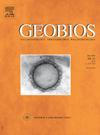New material of the small raoellid artiodactyl Metkatius kashmiriensis Kumar and Sahni, 1985 (Mammalia) from the middle Eocene of the Kalakot area, Rajouri District, Jammu and Kashmir, India
IF 1.6
4区 地球科学
Q2 PALEONTOLOGY
引用次数: 0
Abstract
New material of the small raoellid artiodactyl Metkatius kashmiriensis is reported from the middle Eocene of the Upper Subathu Formation in the Kalakot area, Jammu and Kashmir, northwest Himalaya, India. The fossil material consists of numerous mandibular and maxillary fragments and isolated teeth, mainly belonging to juvenile specimens. It documents the poorly known dental morphology of M. kashmiriensis and provides an overview of its intraspecific variation, allowing to redefine its diagnosis. M. kashmiriensis is characterized by a particularly small size compared with other raoellid species, and by bunodont molars with moderately marked transverse lophs. The M/1–2 are much longer than wide and display characters similar to those of Rajouria gunnelli, such as the presence of a small paraconid and a mesial mesiostylid. The P/4 bears distally a small hypoconid, which appears to be unique in Raoellidae. The description of the new material also allows to document the poorly known morphology of the deciduous teeth of raoellids. The DP2/ is reported for the first time, and the DP/4 of M. kashmiriensis shows a morphology different from that of Indohyus, with the absence of mesial basin anterior to the paraconid and the primoconid. Contrary to what has recently been proposed, these results confirm that M. kashmiriensis is a valid species and not a synonym of Indohyus indirae, and highlight the great morphological diversity present within the Raoellidae during the middle Eocene in the Indian subcontinent.
印度查谟和克什米尔Rajouri地区Kalakot地区小型raoelid偶蹄类Metkatius kashmiriensis Kumar和Sahni, 1985(哺乳类)的新材料
报道了印度喜马拉雅西北部查谟和克什米尔地区卡拉科特地区中始新世上Subathu组小型raoellid偶蹄动物Metkatius kashmiriensis的新材料。化石材料由大量的下颌骨碎片和分离的牙齿组成,主要属于青少年标本。它记录了鲜为人知的M. kashmiriensis的牙齿形态,并提供了其种内变异的概述,允许重新定义其诊断。喀什米尔猿人的特点是与其他类人猿相比体型特别小,臼齿有中等程度的横纹。M/ 1-2比宽长得多,显示出与拉朱里亚相似的特征,例如存在一个小的副孔和一个中孔柱体。P/4的上部有一个小的下圆锥,这在Raoellidae中似乎是独一无二的。新材料的描述也允许记录鲜为人知的raoelids乳牙的形态。M. kashmiriensis的DP2/为首次报道,其DP/4形态与Indohyus不同,在副圆锥体和原圆锥体前没有中缘盆地。与最近提出的观点相反,这些结果证实了M. kashmiriensis是一个有效的物种,而不是Indohyus indirae的同义词,并突出了始新世中期印度次大陆Raoellidae中存在的巨大形态多样性。
本文章由计算机程序翻译,如有差异,请以英文原文为准。
求助全文
约1分钟内获得全文
求助全文
来源期刊

Geobios
地学-古生物学
CiteScore
3.30
自引率
6.20%
发文量
28
审稿时长
6-12 weeks
期刊介绍:
Geobios publishes bimonthly in English original peer-reviewed articles of international interest in any area of paleontology, paleobiology, paleoecology, paleobiogeography, (bio)stratigraphy and biogeochemistry. All taxonomic groups are treated, including microfossils, invertebrates, plants, vertebrates and ichnofossils.
Geobios welcomes descriptive papers based on original material (e.g. large Systematic Paleontology works), as well as more analytically and/or methodologically oriented papers, provided they offer strong and significant biochronological/biostratigraphical, paleobiogeographical, paleobiological and/or phylogenetic new insights and perspectices. A high priority level is given to synchronic and/or diachronic studies based on multi- or inter-disciplinary approaches mixing various fields of Earth and Life Sciences. Works based on extant data are also considered, provided they offer significant insights into geological-time studies.
 求助内容:
求助内容: 应助结果提醒方式:
应助结果提醒方式:


